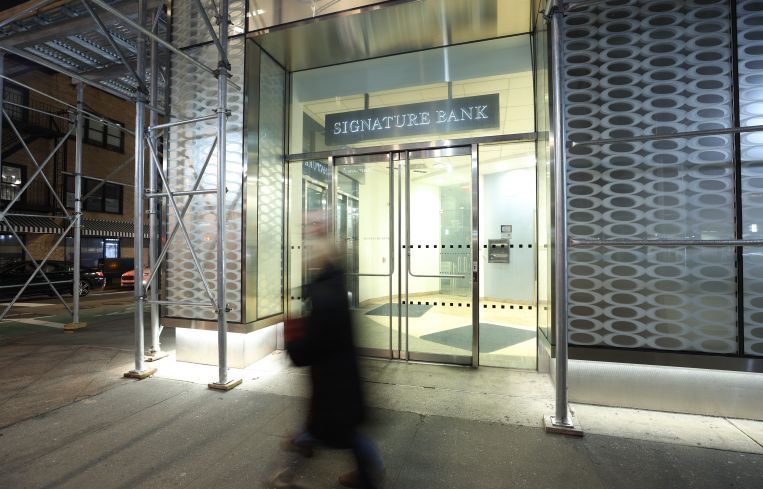Regulators Assign and Accept Blame in SVB and Signature Bank Crashes
Regulators blasted the banks’ management but also said they fell short in supervising vulnerable institutions
By Brian Pascus April 28, 2023 2:25 pm
reprints
The Federal Reserve and Federal Deposit Insurance Corporation (FDIC) released a pair of scathing post-mortem reports Friday that examined how Silicon Valley Bank (SVB) and Signature Bank collapsed in March, blaming the management at both banks for chasing short-term profits and failing to manage risk.
The two federal regulators also pointed the finger at themselves for failing to adequately supervise both institutions, and emphasized that new guardrails must be put in place to stave off another regional banking catastrophe. Both agencies said they missed weakness in both banks prior to their collapses, with the FDIC blaming a lack of staff to conduct targeted reviews of Signature.
The Federal Reserve report — commissioned on March 13 by Michael Barr, vice chair of supervision at the Fed — argued that SVB failed on March 10 because of “a textbook case of mismanagement by a bank,” and said its senior leadership “failed to manage basic interest rate and liquidity risk.”
“The full board of directors did not receive adequate information from management about risks at [SVB] and did not hold management accountable for effectively managing the firm’s risks,” the report read. “The bank failed its own internal liquidity stress tests and did not have workable plans to access liquidity in times of stress.”
Perhaps most damning, the Fed concluded SVB’s executive leadership altered its own risk-management models to remove hedges for interest rate increases and created compensation packages built around short-term earnings and equity returns, without any risk metrics attached to them.
“The board put short-run profits above effective risk management and often treated resolution of supervisory issues as a compliance exercise rather than a critical risk-management issue,” the report said. “As such, managers had a financial incentive to focus on short term profit over sound risk management.”
After losing more than $40 billion of deposits on March 9, SVB collapsed and was taken over by the FDIC. Prior to its March 10 seizure, SVB management alerted federal regulators that they expected to lose more than $100 billion in deposits, roughly 85 percent of its deposit base, that day.
The Fed said that the speed of the deposit withdrawals was unprecedented and tied to the interconnectivity of depositors using social media, a relatively new phenomenon. The report noted that the 2008 failures of Wachovia and Washington Mutual saw $10 billion in deposit outflows over eight days, and $19 billion in outflows over 16 days, respectively.
“The combination of social media, a highly networked and concentrated depositor base, and technology may have fundamentally changed the speed of bank runs,” the report said. “Social media enabled depositors to instantly spread concerns about a bank run, and technology enabled immediate withdrawals of funding.”
The FDIC report — authored by chief risk officer Marshall Gentry -– offered similar criticisms about the management of Signature Bank, which was seized by regulators on March 12. The FDIC said that Signature Bank failed to prioritize good government practices and often ignored FDIC advisory recommendations prior to its sudden collapse.
“The root cause of Signature Bank’s failure was poor management,” the report said. “[Signature Bank’s] board of directors and management pursued rapid, unrestrained growth without developing and maintaining adequate risk-management practices and controls appropriate for the size, complexity and risk profile of the institution.”
Signature Bank had total deposits of $88.6 billion and total assets of $110.4 billion around the time it collapsed. The bank had entered into the cryptocurrency sphere in the early 2020s, making a series of loans and investments that opened up Signature’s balance sheet to vulnerabilities once the crypto industry took a nosedive in late 2022.
“[Signature Bank] funded its rapid growth through an over-reliance on uninsured deposits without implementing fundamental liquidity risk-management practices and controls,” the report said. “Additionally, [Signature Bank] failed to understand the risk of its association with and reliance on crypto industry deposits or its vulnerability to contagion from crypto industry turmoil that occurred in late 2022 and into 2023.”
As much as the federal regulators chastised the banks for poor management and self-inflicted wounds, the watchdogs also criticized themselves for failing to do a good enough job monitoring a vulnerable system.
The Federal Reserve report said its oversight team “did not appreciate the seriousness of critical deficiencies” in SVB’s governance, liquidity and risk-management system, and that this failure helped SBV remain a well-rated bank up until the moment it collapsed. The Federal Reserve said it needs to re-evaluate how it supervises a bank’s management of interest rate risk, as well as its liquidity risk, notably the risks of uninsured deposits, in the future.
“Regulatory standards for SVB were too low, the supervision of SVB did not work with sufficient force and urgency, and contagion from the firm’s failure posed systemic consequences not contemplated by the Federal Reserve’s tailoring framework,” the report said.
The FDIC pulled no punches on its own shortcomings.
Even though the agency had completed several targeted reviews of Signature Bank prior to its collapse, the agency said it could have “escalated supervisory actions sooner” and that its timely communication with the bank “could have been more effective.”
Ultimately, the FDIC blamed a failure to adequately monitor Signature Bank on a lack of manpower.
“From 2017 to 2023, the FDIC was not able to adequately staff an examination team dedicated to [Signature],” the report said. “Certain targeted reviews were not completed timely or at all because of resource shortages. These vacancies … slowed earlier identification and reporting of [Signature] weaknesses.”
Brian Pascus can be reached at bpascus@commercialobserver.com


